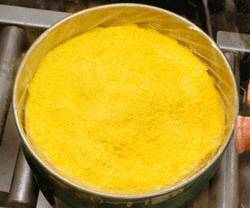US considers options for its uranium stocks
18 December 2008
The US Department of Energy has a plan to release a large part of its uranium holdings to the market. Stocks of Russian origin are earmarked for the first cores of new US reactors.
 |
| Uranium oxide, U3O8, during canning |
The uranium would enter the market over the next decade in a range of forms: low-enriched uranium feed suitable for use as reactor fuel; natural unenriched uranium in the gaseous form uranium hexafluoride ready for enrichment; and natural uranium oxide.
These materials would have been sourced respectively from high-enriched uranium from unwanted US weapons, depleted uranium stocks left over from historic DoE enrichment work; and a stockpile of Russian-origin uranium bought under a 1993 agreement. There is also a grab-bag of uranium forms from places such as universities that could be processed for potential sale.
Detailing its plans and options for managing all this, the DoE said that it would maintain a uranium reserve of 670 tonnes - equivalent to about 20 power reactor reloads - for energy security reasons. This would be kept as low-enriched uranium and could be stored either at the DoE's Portsmouth or Paducah sites, or kept as part of a commercial entity's working inventory.
Using the April 2008 market price for uranium, the DoE calculated its 75,300 tonne stocks of depleted uranium hexafluoride to be worth about $3.4 billion after re-enrichment.
The DoE's plan shows a grand total of 59.1 million pounds of uranium oxide entering global markets before the end of FY2017.
The DoE said one of its managing principles is that not more than 10% of US annual requirements would be delivered to the market in any one year - apart from an allocation for the first cores of newly built US reactors.
In line with this, the annual quantity coming from dismantled weapons and re-enriched uranium increases steadily to reach 5 million pounds in 2013 and then continues at that level, totalling 39.1 million pounds.
Between the years 2010 and 2015, another 20 million pounds from Russian-origin stocks is allocated for the first cores of newly built reactors in the USA.
The DoE report said that uranium transactions with entities outside the US government would be conducted in a transparent and competitive manner, and result in a reasonable value returning to the government. However, future energy secretaries would be able to change those priorities for the benefit of overriding DoE needs and in the light of each transaction's relationship to DoE objectives.